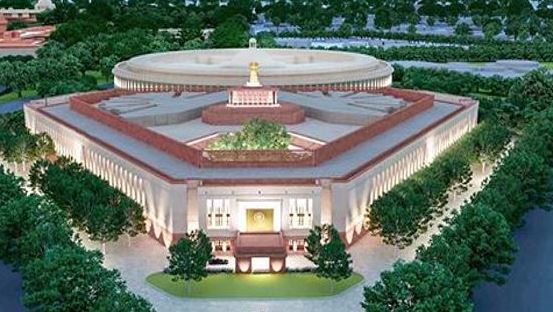
Prime Minister Narendra Modi would on May 28 inaugurate the New Parliament Building—the power seat of the Indian democratic system. The government has sent invitations for the event to leaders across the country, however, a huge controversy has broken out amid demands that President Droupadi Murmu should inaugurate the new Parliament.
Leaders of several political parties have decided to boycott the event over the issue.
The new building
The Prime Minister laid the foundation stone of the triangular shaped new Parliament building in December, 2020.
Calling it “milestone in India’s democratic history”, he also recalled the time when he entered the Parliament for the first time in 2014 as an MP, bowing his head before the temple of democracy.
Adjacent to the present circular Parliament, the new building is modern, state-of-the-art, energy efficient building with highly non-obtrusive security facilities. Its interiors showcase a rich blend of Indian culture and diversity of India’s regional arts, crafts, textiles and architecture, according to official statements.
The new building can comfortably seat 888 members in the Lok Sabha chamber and 300 in the Rajya Sabha chamber, as per the Lok Sabha Secretariat. In case of a joint sitting of both the Houses, as many as 1,280 members can be seated.
The design plan also includes space for a Central Constitutional Gallery, which will be accessible to the public.
The controversies
The day of inauguration happens to be the birth anniversary of Hindutva ideologue Vinayak Damodar Savarkar who has been a part of an ongoing war of words between the ruling BJP and the Congress.
May 28 is the 140th birth anniversary of Veer Savarkar and many political observers believe that could be one of the reasons for objections by some political parties.
This apart, the inception and construction of the new building remained mired in several controversies, including the time when PM Modi unveiled the National Emblem cast on the roof of the New Parliament Building in July 2022.
The allegation was that it was not a faithful replica of the Sarnath original.
Questions have been raised whether India could afford to spend huge amounts of money on a project that was not really needed. A large part of the work was carried out when Covid-19 was at its peak and there was criticism over the construction work being carried out during the lockdown.
The Central Vista Committee had cleared the new Parliament building in an online meeting on April 23, 2020.
Doubts were raised about the process adopted to select the design consultants, the manner in which permissions and clearances were given.
Several petitions were also filed in the Supreme Court regarding this.
New Parliament
According to the Ministry of Urban Development, the present building was never designed to accommodate a bicameral legislature for a full-fledged democracy and the freeze on total number of seats is only till 2026.
“The number of Lok Sabha seats has remained unaltered at 545 based on the delimitation carried out on the basis of 1971 Census. It is likely to increase substantially after 2026 as the freeze on total number of seats is only till 2026. The seating arrangements are cramped and cumbersome, with no desks beyond the second row. The Central Hall has seating capacity only for 440 persons. When the Joint Sessions are held, the problem of limited seats amplifies. Due to limited space for movement, it is also a huge security risk,” the MoUD website states.
Over the years, the parliamentary activities and the number of people working therein and visitors have increased manifold, it adds.
Current Parliament House
India’s present Parliament House is almost 100 years old and a Heritage Grade-I building.
It was designed by British architects Sir Edwin Lutyens and Herbert Baker and took six years to construct (1921-1927).
Originally called the Council House, the building housed the Imperial Legislative Council.
Two more floors were added in 1956 to address the demand for more space.
In 2006, the Parliament Museum was added to showcase the 2,500 years of rich democratic heritage of India.
The building had to be modified to a large extent to suit the purpose of a modern Parliament.





















